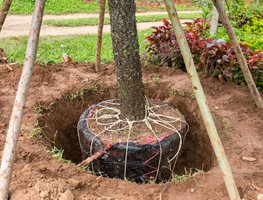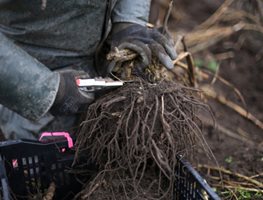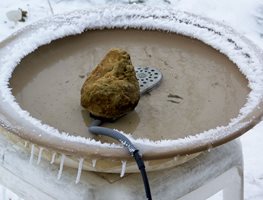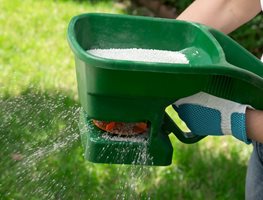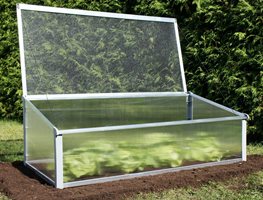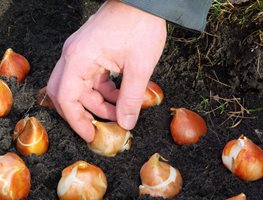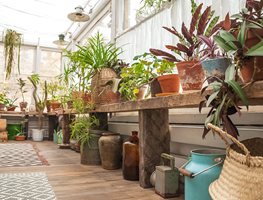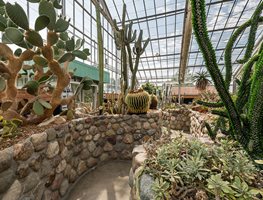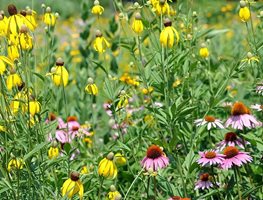10 Gardening Activities for October in the Midwest
Here are a few garden reminders, inspiring ideas, maintenance tips, and places to visit this month.
1. Plant Trees & Shrubs
Fall is the best time to plant most trees and shrubs because it brings cooler—but still warm—weather, which is good for root growth. Typically, there’s also more consistent rain. The Chicago Botanical Garden lists a few exceptions that are better planted in Spring: dogwood, Japanese maple, magnolia, redbud, rhododendron, and viburnum. As long as the ground is not frozen, you can plant. For a guide to planting trees, check out resources from Arbor Day Foundation. They have detailed information (through articles and videos) about how to plant different types of trees such as bare root, containerized, or balled and burlapped. Be sure to water your new tree well when planting and then consistently afterward. Use mulch to help retain moisture and keep roots cool. You can even bring your tree planting indoors. Check out these indoor topiaries from Terrain: rosemary and lemon cypress.
2. Dig Up & Store Tender Plants
Some tender plants need to be dug up and stored for the winter, and then replanted in spring. This includes a variety of bulbs, corms, tubers, and rhizomes such as dahlias, cannas, caladiums, gladiolus, elephant ears, and calla lilies. To lift dahlia tubers for example (a very popular crop), dig up clumps using a digging fork or garden spade. One of the top flower growers in the country, Floret, recommends just digging them up, shaking off the dirt, placing them in deep crates, and putting them in a 40- to 50-degree Fahrenheit storage room for the winter (read more about Floret's process). With other tender plants, you can follow a similar process. Some experts recommend rinsing, and possibly dividing before placing them in a box or crate for storage. Read about how the Missouri Botanical Garden digs and stores cannas. Depending on your climate, you may need to dig up plants in November. You’ll know it’s time when frost has killed foliage and leaves are yellow or dying back.
3. Prepare Ponds, Birdbaths & Water Features for Freezes
Often, the first freeze can sneak up fast. Be sure you’re prepared. If you have a pond, have a working pond de-icer at the ready if you have fish or other aquatic life. It’s good to test your pond de-icers now to make sure they are working after they’ve sat in storage. If you need a new one, try the Laguna PowerHead Heated De-Icer. Watch this video on how to use de-icers. You can also test birdbath heaters. If you decide to let your pond or water features freeze for the winter, make sure to blow-out pipes (remove water from the lines). Otherwise, they might burst and cause damage. Do this yourself or hire a local landscape contractor. If you’re taking down your birdbaths for the season, remove them from the garden and store them in a protected location. If water is left in the bowl or if it gets into the base, it may cause damage when it freezes.
4. Fertilize Your Lawn
You don’t want to apply too many applications of fertilizer this late in the season, so if you fertilized in September skip fertilization in October. Otherwise, apply a high-nitrogen fertilizer such as 3-1-2. Doing so will help your lawn perform better come spring because it’ll have the proper nutrients to use early in next season’s growth cycle.
5. Prepare for Winter Growing or Clear Kitchen Garden Beds
Just because freezing weather is coming doesn’t mean you have to stop growing food. Eliot Coleman pioneered growing a four-season garden in Maine. His books and efforts to popularize cold-weather growing and small farming are far ranging—he even has a line of highly useful tools for growers at Johnny’s Selected Seeds. Books he’s written such as the Four-Season Harvest are great resources for winter growing. To grow during the winter it helps to have some type of structure for frost protection such as a raised bed cold frame, commercial cold frame, or greenhouse. If you’re not going to keep your kitchen garden going through winter, now is the time to remove all plant material. Apply compost and a balanced vegetable garden fertilizer to the soil. This will prepare the garden beds for next season. You can also grow a cover crop such as crimson clover, mustard, or fava beans. These crops help keep the soil healthy by restoring nitrogen and an adding organic matter.
Don't miss what to do in the garden each month, make sure you're getting our weekly newsletter.
6. Continue Planting Bulbs
You may have started planting your bulbs in September. Continue planting bulbs through October as long as the ground is still workable. To plant bulbs, a general rule of thumb is to plant them 3 times as deep as the bulb is tall. (If the bulb is 3 inches tall, then plant it 9 inches deep.) If you’re digging individual holes for each bulb it helps to have a bulb auger. There are also ways to plant masses of bulbs quickly when you’re planting only one type that’s the same size in a mass (tulips, for example). Dig out a large area (perhaps 6 feet long by 3 feet wide) to the proper depth for planting. This area can fit around 100 bulbs. Then set each bulb inside and cover with soil. Last, tamp down the soil. Learn more about planting flower bulbs.
7. Harvest Pumpkins, Winter Squash & Gourds
By October most pumpkins, winter squash, and gourds are ready to be harvested—harvest usually occurs in September or October depending on planting time and climate. You’ll know that a fruit is ready to harvest when it is uniformly the color shown on the seed packet or online. Vines will also start to dry when fruits are ripe, so a colorful fruit with brown leaves is a good sign it’s time to harvest. To harvest, clip stems with loppers or sharp garden pruners. Make sure to do this before the first frost because frost can destroy the fruits. Read more about harvesting pumpkins at the University of Illinois Extension.
8. Bring in Tropical Plants
It’s a treat to grow tropical plants in the Midwest, but you need to give them extra care as cold weather approaches. If you’re growing tropicals such as angel’s trumpet, hibiscus, abutilon, alocasia, bananas, desert rose, or tree ferns, it’s time to bring them indoors to a protected location with high light for the winter. If you’ve planted tropicals in the ground, dig them up and pot them in a container for relocation, if necessary. Plants that are already in pots can be moved as they are. Be sure to spray down containers and check for pests before bringing them indoors. See our guide to bringing outdoor plants inside.
9. Get to a Greenhouse
Visiting greenhouses is a great way to spend cool October days. Many of the botanic gardens around the Midwest have beautiful greenhouses with extensive collections of tropical plants, semitropical plants, desert plants, and more. Check out these greenhouses around the Midwest: Chicago Botanic Garden, Linnean House at the Missouri Botanical Garden, Greater Des Moines Botanical Garden Conservatory, Conservatory at Matthaei Botanical Gardens (University of Michigan), Como Park Zoo & Conservatory.
10. Scatter Wildflower Seeds
Wildflowers native to the Midwest are generally best planted in fall. The first step in planting wildflowers is soil preparation. Be sure to remove any plants from the space. To prevent weed infestation, solarization (or another weed control method) will help kill the seed base already in the soil. If soil is poor, add a layer of organic compost to the site before scattering seed. Get the soil wet upon planting to help seeds settle in (but don’t overwater because seeds may be carried off by excess water). For a complete overview of wildflower seed planting, visit the Xerces Society for a Pollinator Meadow Installation Guide & Checklist for the Upper Midwest. To purchase a native wildflower seed mix, visit American Meadows or High Country Gardens.
If you enjoyed this information, sign up for our weekly newsletter. Each week, you'll get Garden Design's best delivered right to your inbox including design tips, plant picks, great gardens, outdoor living products, and events to enjoy — along with monthly gardening checklists just for your area.
Do you know someone who would enjoy this Midwest Region gardening information? Why not share it with them?
When you purchase products through links on our site, we may receive an affiliate commission. Thank you for your support.
